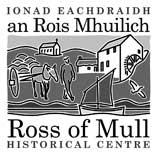The District of Ardtun
During the mid 19th century, the area became densely populated when many of the people, cleared from other areas of Mull, were settled in Ardtun. The 1861 census states that Ardtun, despite having the poorest soil, was one of the most densely populated areas in the Ross, with a population of 346 people. They were crofters and cottars, supplementing their incomes at various times with other industries such as weaving, kelp processing and shoemaking.
The land hosts a great variety of wildflowers and bird life to be seen over a wide range of habitats. Much of the area is made up from peat and glacial desposits; the north western coastline is pocketed with caves and gullies, between colums and sheer cliffs of basalt. Part of the peninsula has been classified as a Site of Special Scientific Interest as it includes one of Scotland's geological gems, the Leaf Beds of Ardtun.
